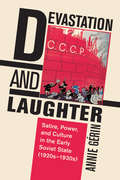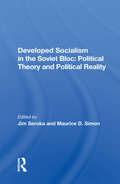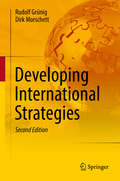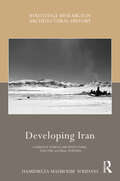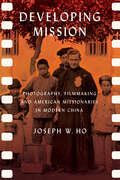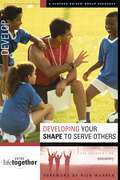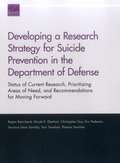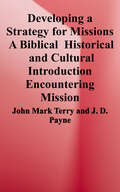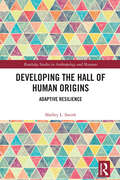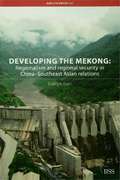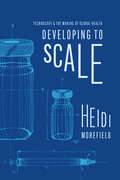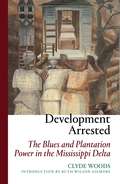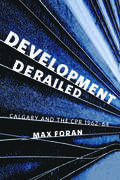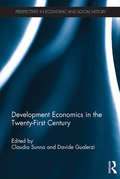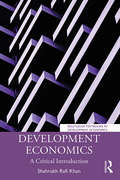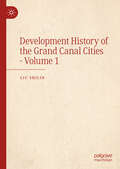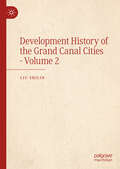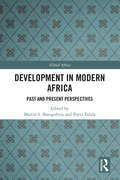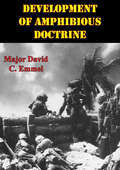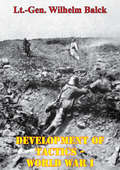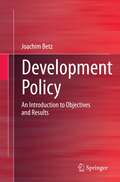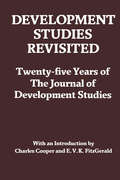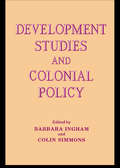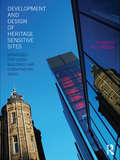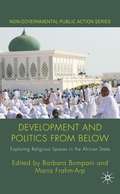- Table View
- List View
Devastation and Laughter: Satire, Power, and Culture in the Early Soviet State (1920s–1930s)
by Annie GérinIn Devastation and Laughter, Annie Gérin explores the use of satire in the visual arts, the circus, theatre, and cinema under Lenin and Stalin. Gérin traces the rise and decline of the genre and argues that the use of satire in official Soviet art and propaganda was neither marginal nor un-theorized. The author sheds light on the theoretical texts written in the 1920s and 1930s by Anatoly Lunacharsky, the Soviet Commissar of Enlightenment, and the impact his writings had on satirists. While the Avant-Garde and Socialist Realism were necessarily forward-looking and utopian, satire afforded artists the means to examine critically past and present subjects, themes, and practice. Devastation and Laughter is the first work to bring Soviet theoretical writings on the use of satire to the attention of scholars outside of Russia. By introducing important bodies of work that have largely been overlooked in the fields of art history, film and theatre history, Annie Gérin provides a nuanced and alternative reading of early Soviet art.
Developed Socialism In The Soviet Bloc: Political Theory Vs. Political Reality
by Jim Seroka Maurice D. SimonThis book traces the evolution of Soviet and East European responses to the multifaceted pressures of a rapidly changing world and looks at the implications of ideological developments in the Soviet bloc for economic reforms, general policymaking, and political and social change. The authors discuss the concept of developed socialism and its essential components as seen in communist societies; analyze current policy and likely future policy directions in the Soviet Union, Czechoslovakia, Hungary, Romania, Poland, and Yugoslavia in light of the concept; and assess the impact that ideological trends have had, and are likely to have, on the Soviet Union and Eastern Europe in general.
Developing International Strategies
by Rudolf Grünig Dirk MorschettThis book helps medium-sized companies adapt to the challenges and take advantage of the opportunities of the growing international business climate. The authors offer practical, usable advice on production, sourcing and strategic planning.
Developing Iran: Company Towns, Architecture, and the Global Powers (Routledge Research in Architectural History)
by Hamidreza Mahboubi SoufianiThis book examines the emergence of modern company towns in Iran by delineating the architectural, political, and industrial histories of three distinct resource-based ‘company town’ projects built in association with the ‘Big Three’ powers of World War II. The book’s narrative builds upon a tripartite research design that chronologically traces the formation and development of the oil, steel, and copper industries, respectively favoured by Great Britain, the Soviet Union, and the United States in this part of the world. By applying three sets of comparative studies, the book provides critical vantage points to three different ideological design paradigms: postcolonial regionalism, socialist universalism, and rationalist modern nation building. From a global political context, the book contributes to the disclosure of new information about the geopolitical confrontation of these three nations in the Global South to increase their sphere of influence after the Second World War. Furthermore, it demonstrates how postwar architectural modernism was adopted by each power and adapted to their ideological mind frame to fulfil distinct social, cultural, political, and economic targets. This book examines multiple interconnections between architecture, politics, and industrial development by adopting a transdisciplinary approach based on comprehensive fieldwork, site surveys, and the analysis of original multilingual documents. As such, it will be of interest to researchers and students of architecture, history, international relations, and Middle Eastern studies.
Developing Mission: Photography, Filmmaking, and American Missionaries in Modern China (The United States in the World)
by Joseph W. HoIn Developing Mission, Joseph W. Ho offers a transnational cultural history of US and Chinese communities framed by missionary lenses through time and space—tracing the lives and afterlives of images, cameras, and visual imaginations from before the Second Sino-Japanese War through the first years of the People's Republic of China. When American Protestant and Catholic missionaries entered interwar China, they did so with cameras in hand. Missions principally aimed at the conversion of souls and the modernization of East Asia, became, by virtue of the still and moving images recorded, quasi-anthropological ventures that shaped popular understandings of and formal foreign policy toward China. Portable photographic technologies changed the very nature of missionary experience, while images that missionaries circulated between China and the United States affected cross-cultural encounters in times of peace and war. Ho illuminates the centrality of visual practices in the American missionary enterprise in modern China, even as intersecting modernities and changing Sino-US relations radically transformed lives behind and in front of those lenses. In doing so, Developing Mission reconstructs the almost-lost histories of transnational image makers, subjects, and viewers across twentieth-century China and the United States.
Developing Your SHAPE to Serve Others: Six Sessions on Ministry (Doing Life Together)
by Brett EastmanThe way you’re wired is no accident! God designed your unique mix of gifts, natural abilities, personality, values, and life experiences to play an essential part in his kingdom. These six sessions will help you develop your God-given design at home, at work, at church, and in your community in a way that extends God’s love to others and enriches your own life immeasurably. “Doing Life Together is a groundbreaking study…[It’s] the first small group curriculum built completely on the purpose-driven paradigm…The greatest reason I’m excited about [it] is that I’ve seen the dramatic changes it produces in the lives of those who study it.” —From the foreword by Rick Warren Based on the five biblical purposes that form the bedrock of Saddleback Church, Doing Life Together will help your group discover what God created you for and how you can turn this dream into an everyday reality. Experience the transformation firsthand as you begin Connecting, Growing, Developing, Sharing, and Surrendering your life together for him.
Developing a Research Strategy for Suicide Prevention in the Department of Defense: Status of Current Research, Prioritizing Areas of Need, and Recommendations for Moving Forward
by Terri Tanielian Rajeev Ramchand Phoenix Voorhies Nicole K. Eberhart Christopher Guo Eric Pedersen Terrance Dean SavitskyTo support U. S. Department of Defense (DoD) efforts to create a unified, comprehensive strategic plan for suicide prevention research, a RAND study cataloged studies funded by DoD and other entities, examined whether current research maps to DoD's strategic research needs, and provided recommendations to encourage better alignment and narrow the research-practice gap when it comes to disseminating findings to programs serving military personnel.
Developing a Strategy for Missions: A Biblical, Historical, and Cultural Introduction (Encountering Mission)
by J. D. Payne John Mark TerryIn this addition to the highly acclaimed Encountering Mission series, two leading missionary scholars offer an up-to-date discussion of missionary strategy that is designed for a global audience. The authors focus on the biblical, missiological, historical, cultural, and practical issues that inform and guide the development of an effective missions strategy. The book includes all the features that have made other series volumes useful classroom tools, such as figures, sidebars, and case studies. Students of global or domestic mission work and mission practitioners will value this new resource.
Developing the Hall of Human Origins: Adaptive Resilience (Routledge Studies in Anthropology and Museums)
by Shelley L. SmithThis book focuses on the development of the National Museum of Natural History’s David H. Koch Hall of Human Origins. As one of the most visited human evolution exhibits in the world and the largest such exhibit in the United States, it has tremendous influence on public perception and knowledge of human evolution. The chapters explore how this exhibit came about, how it has changed since opening, and the associated educational and public outreach activities of members of the Smithsonian’s Human Origins Program. The author uses the term “adaptive resilience” to describe a central theme of the exhibit, our species’ adaptation to changing environments as a key feature of our success, and to refer to the resilience of Richard B. Potts in creating his vision for the hall. Contextual sections situate the hall’s development within the history of paleoanthropology, the politics of evolution and climate change, and African contributions. The book will be of particular interest to scholars of anthropology and museum studies as well as the history of science and science communication.
Developing the Mekong: Regionalism and Regional Security in China–Southeast Asian Relations (Adelphi series)
by Evelyn GohIn Southeast Asia, China’s growing economic and political strength has been accompanied by adept diplomacy and active promotion of regional cooperation, institutions and integration. Southeast Asian states and China engage in ‘strategic regionalism’: they seek regional membership for regime legitimation and collective bargaining; and regional integration to enhance economic development, regarded as essential for ensuring national and regime security. Sino-Southeast Asian regionalism is exemplified by the development plans for the Mekong River basin, where ambitious projects for building regional infrastructural linkages and trade contribute to mediating the security concerns of the Mekong countries. However, Mekong regionalism also generates new insecurities. Developing the resources of the Mekong has led to serious challenges in terms of governance, distribution and economic externalities. Resource-allocation and exploitation conflicts occur most obviously within the realm of water projects, especially hydropower development programmes. While such disputes are not likely to erupt into armed conflict because of the power asymmetry between China and the lower Mekong states, they exacerbate Southeast Asian concerns about China’s rise and undermine Chinese rhetoric about peaceful development. But the negative security consequences of developing the Mekong are also due to the shared economic imperative, and the Southeast Asian states’ own difficulties with collective action due to existing intramural conflicts.
Developing to Scale: Technology and the Making of Global Health
by Heidi MorefieldThe first critical book on “appropriate technology,” Developing to Scale shows how global health came to be understood as a problem to be solved with the right technical interventions. In 1973, economist E. F. Schumacher published Small Is Beautiful, which introduced a mainstream audience to his theory of “appropriate technology”: the belief that international development projects in the Global South were most sustainable when they were small-scale, decentralized, and balanced between the traditional and the modern. His theory gained widespread appeal, as cuts to the foreign aid budget, the national interests of nations seeking greater independence, postcolonial activism, and the rise of the United States’ tech sector drove stakeholders across public and private institutions toward cheaper tools. In the ensuing decades, US foreign assistance shifted away from massive modernization projects, such as water treatment facilities, toward point-of-use technologies like village water pumps and oral rehydration salts. This transition toward the small scale had massive implications for the practice of global health. Developing to Scale tells the history of appropriate technology in international health and development, relating the people, organizations, and events that shaped this consequential idea. Heidi Morefield examines how certain technologies have been defined as more or less “appropriate” for the Global South based on assumptions about gender, race, culture, and environment. Her study shows appropriate technology to be malleable, as different constituencies interpreted its ideas according to their own needs. She reveals how policymakers wielded this tool to both constrain aid to a scale that did not threaten Western interests and to scale the practice of global health through the development and distribution of technical interventions.
Development Arrested: The Blues and Plantation Power in the Mississippi Delta
by Ruth Wilson Gilmore Clyde WoodsDevelopment Arrested is a major reinterpretation of the two-centuries-old conflict between the African Americans and planters in the Mississippi Delta. In a definitive study of the history and social structures of the plantation system, Clyde Woods examines both planter domination of politics and economy in the region and the continuing resistance of the African American working class to the system’s depredations. "Development Arrested" traces the decline and resurrection of plantation ideology in national public policy discourse from Thopmas Jefferson to Bill Clinton. Woods documents the unceasing attacks on the gains of the Civil Rights Movement and how, despite having suffered countless defeats at the hands of the planet regime, African Americans in the Delta have continued to push forward their agenda for social, economic, and cultural justice. He ecamines the role of the Blues in sustaining their efforts, surveying a musical tradition-including Jazz, Rock and Rolll, Soul and Rap-that has embraced a radical vision of social change. This is an important contribution to the current political debates involving Mississippi politics, the presidency and Congress, and to our understanding of Black, US, and Southern history.
Development Derailed: Calgary and the CPR , 1962–64
by Max ForanIn June of 1962, the Canadian Pacific Railway announced a proposal to redevelop part of its reserved land in the heart of downtown Calgary. In an effort to bolster its waning revenues and to redefine its urban presence, the CPR proposed a multimillion dollar development project that included retail, office, and convention facilities, along with a major transportation centre. With visions of enhanced tax revenues, increased land values, and new investment opportunities, Calgary’s political and business leaders greeted the proposal with excitement. Over the following year, the scope of the project expanded, growing to a scale never before seen in Canada. The plan took official form through an agreement between the City of Calgary and the railway company to develop a much larger area of land and to reroute or remove the railway tracks from the downtown area—a grand design for reshaping Calgary’s urban core. In 1964, amid bickering and a failed negotiating process, the project came to an abrupt end. What caused this promising partnership between the nation’s leading corporation and the burgeoning city of Calgary to collapse? What, in economic terms, was perceived to be a win-win situation for both parties fell prey to a conflict between corporate rigidity and an unorganized, ill-informed, and over-enthusiastic civic administration and city council. Drawing on the private records of Rod Sykes, the CPR’s onsite negotiator and later Calgary’s mayor, Foran unravels the fascinating story of how politics ultimately undermined promise.
Development Economics in the Twenty-First Century (Perspectives in Economic and Social History)
by Claudia Sunna Davide GualerziDevelopment Economics has been identified as a homogeneous body of theory since the 1950s, concerned both with the study of development issues and with the shaping of more effective policies for less advanced economies. Development Economics in the Twenty-First Century brings together an international contributor team in order to explore the origins and evolution of development economics. This book highlights the different elements of ‘high development theory’ through a precise reconstruction of the different theoretical approaches that developed between the 1950s and the 1970s. These include the theory of balanced and unbalanced growth theory, the debate on international trade, the concept of dualism, dependency theory, structuralism and the analysis of poverty and institutions. The chapters highlight the relevance and usefulness of these analyses for the contemporary theoretical debate on development issues. Comparative perspectives are explored and analysed, including those of Keynes, Hirschman, Krugman and Stiglitz. The chapters situate development economics within current debates among economists and historians of economic thought, providing a platform for future research. This book is suitable for researchers and students with an interest in Development Economics, the History of Economic development and the Economics of Developing Countries.
Development Economics: A Critical Introduction (Routledge Textbooks in Development Economics)
by Shahrukh Rafi KhanFollowing the 2007–2009 financial and economic crises, there has been an unprecedented demand among economics students for an alternative approach, which offers a historical, institutional and multidisciplinary treatment of the discipline. Economic development lends itself ideally to meet this demand, yet most undergraduate textbooks do not reflect this. This book will fill this gap, presenting all the core material needed to teach development economics in a one semester course, while also addressing the need for a new economics and offering flexibility to instructors. Rather than taking the typical approach of organizing by topic, the book uses theories and debates to guide its structure. This will allow students to see different perspectives on key development questions, and therefore to understand more fully the contested nature of many key areas of development economics. The book can be used as a standalone textbook on development economics, or to accompany a more traditional text.
Development History of the Grand Canal Cities - Volume 1
by Liu ShilinThis book presents a comprehensive account of the history of the Grand Canal of China, which is over 6,000 miles long and more than 2,500 years old. The Grand Canal of China flows through Beijing, Tianjin, Hebei, Henan, Shandong, Jiangsu, and Zhejiang, connecting the five major water systems of the Hai River, Huai River, Yellow River, Yangtze River, and Qiantang River, as well as the Central Plains culture, Jiangnan culture, and other cultural resources. The book's core content revolves around 21 pivotal cities along the canal. It draws upon a rich tapestry of authentic historical accounts, local chronicles, poetic traditions, Ming and Qing-era novels, and a plethora of other vivid materials. It encompasses a comprehensive range of subjects, including culture, geography, commerce, water conservancy, and other aspects related to the Grand Canal. It examines the historical and cultural resources associated with the Grand Canal, providing a systematic organization of the cultural assets and modes of life that have developed along its route. The text also explores the significant role that this waterway has played in shaping the spiritual identity of the Chinese people and the nation as a whole.
Development History of the Grand Canal Cities - Volume 2
by Liu ShilinThis book presents a comprehensive account of the history of the Grand Canal of China, which is over 6,000 miles long and more than 2,500 years old. The Grand Canal of China flows through Beijing, Tianjin, Hebei, Henan, Shandong, Jiangsu, and Zhejiang, connecting the five major water systems of the Hai River, Huai River, Yellow River, Yangtze River, and Qiantang River, as well as the Central Plains culture, Jiangnan culture, and other cultural resources. The book's core content revolves around 21 pivotal cities along the canal. It draws upon a rich tapestry of authentic historical accounts, local chronicles, poetic traditions, Ming and Qing-era novels, and a plethora of other vivid materials. It encompasses a comprehensive range of subjects, including culture, geography, commerce, water conservancy, and other aspects related to the Grand Canal. It examines the historical and cultural resources associated with the Grand Canal, providing a systematic organization of the cultural assets and modes of life that have developed along its route. The text also explores the significant role that this waterway has played in shaping the spiritual identity of the Chinese people and the nation as a whole.
Development In Modern Africa: Past and Present Perspectives (Global Africa)
by Toyin Falola Martin S. ShanguhyiaDevelopment in Modern Africa: Past and Present Perspectives contributes to our understanding of Africa’s experiences with the development process. It does so by adopting a historical and contemporary analysis of this experience. The book is set within the context of critiques on development in Africa that have yielded two general categories of analysis: skepticism and pessimism. While not overlooking the shortcomings of development, the themes in the book express an optimistic view of Africa’s development experiences, highlighting elements that can be tapped into to enhance the condition of African populations and their states. By using case studies from precolonial, colonial, and postcolonial Africa, contributors to the volume demonstrate that human instincts to improve material, social and spiritual words are universal. They are not limited to the Western world, which the term and process of development are typically associated with. Before and after contact with the West, Africans have actively created institutions and values that they have actively employed to improve individual and community lives. This innovative spirit has motivated Africans to integrate or experiment with new values and structures, challenges, and solutions to human welfare that resulted from contact with colonialism and the postcolonial global community. The book will be of interest to academics in the fields of history, African studies, and regional studies.
Development Of Amphibious Doctrine
by Major David C. EmmelAlthough the U.S. had conducted amphibious operations since the Revolutionary War, it was not until after the Spanish-American War that the military services attempted to codify procedures in doctrine. Early emphasis focused on command relationships and the responsibilities of commanders, eventually expanding to incorporate operational concepts, tactical techniques, and the necessary equipment. In an environment characterized by inter-service rivalry, as well as monetary and materiel constraints, dedicated individuals and organizations overcame numerous obstacles to develop, practice, and successfully execute amphibious operations in World War II. This thesis examines the evolutionary development of amphibious doctrine by the U.S. Marine Corps, Army, and Navy, and the employment of that doctrine during Operations Watchtower and Torch in World War II. The examination includes an analysis of the historical efforts to develop innovative solutions to a wide range of challenges the services faced at the beginning of the 20th Century leading up to World War II. How the leadership solved those challenges informs the efforts of current leadership in addressing contemporary doctrinal, operational, and tactical challenges and those of the future.
Development Of Tactics - World War I [Illustrated Edition]
by Harry Bell Lt.-Gen. Wilhelm BalckIncludes the First World War Illustrations Pack - 73 battle plans and diagrams and 198 photosLt.-Gen. Wilhelm Balck was a Prussian General, whose service during the First World War with the 51st Division gained him the highest German honour, the coveted Pour le Mérite. Balck was also a noted military writer, in this most valuable study the author discusses the development of tactics within the German Army during World War I. The treatise was considered so valuable that it was immediately translated into English by the U.S. General Service School and widely read. In his native Germany Black's works greatly influenced post-war German thinking about tactics and strategy in the military circles that would become the officer corps of the Wehrmacht.
Development Policy: An Introduction to Objectives and Results
by Joachim BetzDeveloping countries have made rapid but highly varied progress since the 1990s. So much so that the boundaries to the traditional industrialized countries have become partially blurred. On the other hand, there are a number of mostly fragile states that have not succeeded in doing so, or have only rudimentarily succeeded. Talk of one "Third World" and common development problems thus explains little. Instead, development has become a requirement for all states, which this textbook breaks down and assesses according to key development goals.This book is a translation of the original German 1st edition Entwicklungspolitik by Joachim Betz, published by Springer Fachmedien Wiesbaden GmbH, part of Springer Nature in 2021. The translation was done with the help of artificial intelligence (machine translation by the service DeepL.com). A subsequent human revision was done primarily in terms of content, so that the book will read stylistically differently from a conventional translation. Springer Nature works continuously to further the development of tools for the production of books and on the related technologies to support the authors.
Development Studies Revisited: Twenty-five Years of the "Journal of Development Studies"
by Charles Cooper E. V. FitzGeraldFirst published in 1989. The Journal of Development Studies was founded 25 years ago as a professional journal for what had by then become an established sub-discipline within British social science. The Journal has consistently published a broad spectrum of British research on development studies - a catholicity that has been reflected in the composition of the Editorial Board over the years - and has always welcomed authors from the USA, the European Continent, and above all from the Third World. Collated form the last twenty-five years of the journal presented here are a collection of 20-odd papers that represent less than three per cent of articles published since 1964.
Development Studies and Colonial Policy
by Barbara Ingham Colin SimmonsFirst Published in 1987. Routledge is an imprint of Taylor & Francis, an informa company.
Development and Design of Heritage Sensitive Sites: Strategies for Listed Buildings and Conservation Areas
by Kenneth WilliamsonThis is the first book to provide readers with the skills to assess development potential from a holistic standpoint. Until now, architectural books on conservation matters have focused on preservation at a strategic level and restoration at a technical level. This book offers the architect, developer or planner the rules and tools needed to gauge development prospects in an objective and comprehensive manner. Written by an expert in the field it provides the reader with: the latest legislation relating to heritage in the UK insight into local planning authorities and government advisory boards basic strategies for approaching developments an understanding of the options available for developing a heritage site illustrative case studies to highlight strategy successes. This book is a one-stop-shop for any professional or student working in, or learning about, development in heritage environments.
Development and Politics from Below
by Barbara Bompani Maria Frahm-ArpReligion is playing an increasingly central role in African political and developmental life. This book offers an empirical and theoretical reflection on the relationships between religion, politics and development in Africa; the meanings of religion in non-Western contexts and the way that is embedded in the everyday life of people in Africa.
